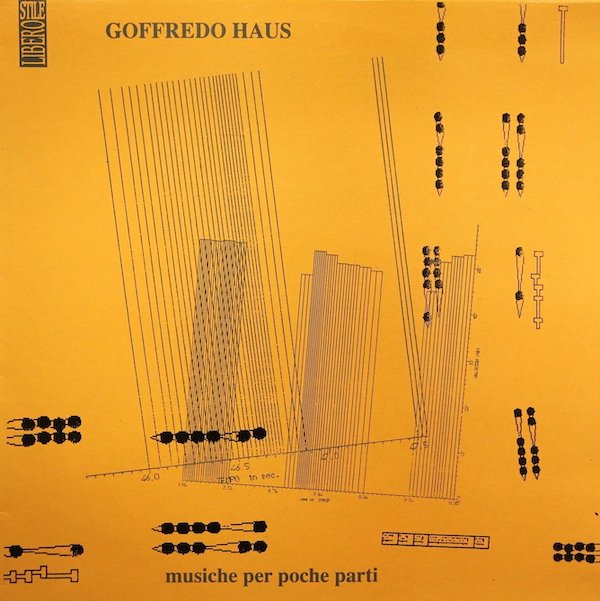
To be completely honest with you, I’m still struggling to assess how to introduce you to Goffredo Haus’s Musiche Per Poche Parti. For many it will easily wear the crown of minimalism and experimental music. For others, who can get past its very silicon-based creation, it might speak to a fourth wave of electro-acoustic music (one tying “antiquated” melodic ideas with “forward-thinking” constructs). David Behrman fans, surely, would find something simpatico here. Anyway, enough knottiness from me. All I’m trying to say is that this album is a heady listen, for sure.
Going by the current history we do know, Goffredo’s beginnings revolved around happenings in his native Milan. Growing up in the ‘60s, an early love of science and scientific study, evolved into a scholarly pursuit of physics and quite early computer music research. By the late ‘70s, Goffredo had transitioned into becoming a computer music consultant for Milan’s Universita Degli Studi and becoming part of a group that pioneered early AI research with the Consorzio Interuniversitario Lombardo Elaborazione Automatica.

In the early ‘80s, Goffredo would become president of the Associazione Informatica Musicale Italiana, an association dedicating itself to finding the bridge between technology, sound, and the human experience. In a matter of decades, Goffredo would witness the transition for theoretical musical ideas becoming real-life ideas — backed up by software and PC hardware — that could actually command compositional ideas he always placed on the backburner as simply not possible.
Things changed around 1985. It was then Goffredo would establish the Laboratorio di Informatica Musicale (LIM), a creative workshop of sorts to promote and interrogate that bridge between sight, sound, and data. There such composers like Riccardo Sinigaglia, Dante Tanzi, and Angelo Paccagnini would man next-generation Macintosh and Amiga computers to create mutant MIDI generative music hybrids.
It wouldn’t be until Italy’s Stile Libero label came knocking that many of his contemporaries and students got a chance to hear various compositions Goffreda had written nearly a decade before but hadn’t quite gotten them to sound (as intended) using simple electric and acoustic instruments. Benefitting from some truly mind bending bit of programming and computing know-how in the span of two year — from 1987 to 1989 — Goffredo hunkered down at LIM and used a bevy of FM and Linear Arithmetic synths, samplers and a Macintosh II to flesh out nearly all-improvised versions of already notated pieces. Then, when warranted, he’d enlist a quartet to add flute, percussion, clarinet and piano.
On paper Musiche Per Poche Parti should sound quite unmusical. Thankfully, what was supposed to begin as a technical showcase for Goffredo’s serialist ideas turned out to be music far more rooted in the accessible ethno-minimalism found in the music of label mates like Paolo Modugno and Tiziano Popoli. Songs, actual listenable ditties, pop up left and right. For every “difficult” track like “Anaritmo” there were three or more instantly wormy tracks like “Dicotomia” and “Momenti Della Mente” that actually valued melody and some sort of personal feeling to meet you halfway.

I don’t want to put too many words in his mouth or ideas in your head but Goffredo creates experimental electro-acoustic music that was refreshingly “human” in spite of all the knowingly inhuman strictures necessary to create its structure. How else do you explain tracks like the obvious highlight, “Cielo”.
Translating to sky, “Cielo” is the album’s centerpiece, one that expresses Goffredo’s now not-so-hidden fascination with punk, prog, and other “overground” musics. Here a haunting melody gets repeated through all sorts of keyed instruments slipping in and out of real and imagined strings. As a quiet hypnotic refrain seems to begin to stay, shifts in dynamics and meter mutate it into an almost alien, self-aware thing, where the computer etches in and out certain, specific, points for maximum punctuation.
Multi-layered, unlike little else, it does so with so few instruments but with various compositional tricks that humans should attempt sans software. For a few moments (as Goffredo’s AI software does it moving) one starts to entertain the idea that there are places this tool will take us when we find a way to lead it there. It appears that this piece, much like many in on this album, were Goffredo’s attempt to bring the ideas of his Scoresynth to use Petri nets, a nodal system of some sort, to take the sometimes antiquated common system of notation into a more user-friendly, symbolic world. All I know is that this album is proof positive that Goffredo found another ghost in the shell to suss out a beige clamshell.
